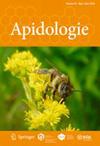Spatio-temporal patterns of Varroa destructor prevalence in Germany inferred from 10-year survey data explain geographic and annual variance in winter colony loss rates of honeybees
Abstract
The parasitic mite Varroa destructor is a main cause for honeybee colony losses. While population dynamics of V. destructor have been studied comprehensively within colonies and/or apiaries, little is known about spatio-temporal dynamics at larger geographic scales. In this paper, we demonstrate that surveys using ranked judgements of V. destructor prevalence and reported online by beekeepers can be used for analyses of population dynamics of V. destructor on a geographic scale. Prevalence indices calculated from the surveys’ data correlated significantly with published quantitative estimates of prevalence between 2013 and 2022 and predicted annual loss rates of honeybee winter colonies at regional and national geographic scales. The annual prevalence evolved in a similar manner among German regions but also revealed substantial variance in prevalence levels among regions. Retrospective epidemiological mapping revealed that geographic clusters of prevalence explained the variance within years. Between years, clusters with relatively low prevalence in 1 year tended to experience relatively higher prevalence than other regions in the following year. The pattern of population dynamics resembles spatial synchrony with population fluctuations and implies an auto-correlative response in annual prevalence trends and hence annual colony losses of honeybees. Online surveys using ranked judgements of V. destructor offer a low-cost method for estimating prevalence trends, which can be disseminated rapidly to beekeepers.

 求助内容:
求助内容: 应助结果提醒方式:
应助结果提醒方式:


